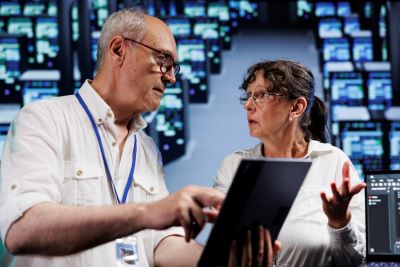National research strategy and “modernized” university-industry partnership needed to stem decline in U.S. science
 NOTE: See also accompanying story, "Expert panel offers suggestions on how to fix the decline in U.S. science."
NOTE: See also accompanying story, "Expert panel offers suggestions on how to fix the decline in U.S. science."
The state of U.S. science is declining and a national research strategy is needed to regain American leadership in science, says the head of the National Academy of Sciences.
China is on track to exceed the U.S. in R&D expenditures, has surpassed the U.S. in patents filed, and has more companies than the U.S. in the international Fortune 500, Dr. Marcia McNutt (photo at right), president of the National Academy of Sciences and chair of the National Research Council, said in an inaugural address on the state of U.S. science.
“There are very worrying trends,” she said. “It is absolutely un-American, in my view, for us to sit back and take an area where we’ve shined and get overtaken by other countries because they’re following our model.”
China now invests twice as much as the U.S. in R&D, she said. In patent numbers, “China blew past the U.S. in about 2015 and is on a meteoric rise.”
The U.S. also is dropping in the percentage of scientific papers being published globally, while scientific publications by China is increasing at triple-digit rates.
China now publishes more of the top one percent of papers than the European Union, McNutt said. “They’re not just putting out bad science, they’re putting out really good science, too.”
China had only three percent of new drugs in the development pipeline globally as recently as 2013, she said. This has increased to 28 percent, “while the U.S. curve is on a slow decline.”
When it comes to U.S. leadership in STEM (science, technology, engineering, mathematics), a public opinion poll by the Science and Technology Action Committee in the U.S. found that 66 per cent of Americans surveyed felt that either the U.S. is being overtaken by other countries or has already been overtaken.
“Only eight per cent felt that we were still in a leadership position,” McNutt said.
She noted that the U.S. has won nearly 60 per cent of 621 Nobel Prizes awarded since the early 1900s. “The U.S. leads in the Nobel tally the way we don’t in anything else. Yet most Americans cannot name a single living scientist.”
Technology companies are first in market value among U.S. Fortune 500 companies, with more than twice the value of the second-place economic sector, McNutt said. Five of the 10 largest pharmaceutical companies are headquartered in the U.S.
“The vitality of the U.S. research enterprise is important, because it benefits our economy, safety, security, health and quality of life.”
In the U.S., STEM is increasingly where the jobs are, as the country shifts from non-STEM employment to STEM employment, McNutt said.
Between 2010 and 2019, the proportion of non-STEM jobs in the U.S. declined by two percent. However, the U.S. STEM workforce, comprised 36.8 million people in diverse occupations, or 24 percent of the total U.S. workforce, in 2021.
The total number of STEM workers without a college degree is 19.3 million workers – 2 million more than those with STEM degrees.
U.S. is dependent on foreign students for STEM workforce
McNutt said several things have changed since 1945, when Vannevar Bush – then- director of the U.S. Office of Scientific Research and Development – wrote the report, “Science: The Endless Frontier,” that became the blueprint for post-war science in America.
One change is that the U.S. has become exceptionally dependent on foreign students. Foreign graduate students in the U.S. now outnumber U.S. students. In postdoctoral researchers, it’s almost a 50-50 split between foreign postdocs and U.S. postdocs.
Foreign-born individuals make up 19 per cent of all STEM workers in the U.S., and 43 percent of STEM workers at the PhD level. They remain in the U.S. after graduation, with a 10-year stay rate of 65 percent.
“We literally couldn’t fill our STEM jobs if it were not for these foreign students coming and staying in the U.S,” McNutt said.
Yet the barriers for foreign students studying in the U.S. are increasing, she added. “It’s now hard to come here from Canada” and other countries.
McNutt said this trend is worrisome, given that a 2023 report from New American Fortune 500 found that 44.8 per cent, or 224 companies, of the U.S. Fortune 500 companies were founded by either immigrants or their children.
“We’ve got to reduce red tape for getting [international study] permits and student work permits,” she said.
As foreign nations increase their investment in R&D, it’s going to be harder to attract foreign students to study and stay in the U.S., McNutt said.
China is now awarding more science and engineering degrees than the U.S., she noted. “Our loss has been their gain.”
To build a foundation for the future U.S. workforce, the country will need to improve K to 12 education nationwide, and make STEM topics attractive and engaging to young students, she said.
However, studies show one-quarter of U.S. fourth-grade students aren’t proficient in math; this rises to more than 35 percent by eighth grade.
“Basically, we’ve allowed other nations to invest in K through 12 training and education for their students,” McNutt said. “And then we ‘steal’ them to come here because we aren’t training our own students well enough.”
“Not only are we not doing a good job of educating these students, we are under-investing in the very institutions [colleges and universities] that are going to give us a more diverse workforce.”
Need to “modernize” university-industry partnerships
Another thing that’s changed, McNutt said, is that in 1945 the U.S. government was the biggest investor in research and development. Since around 1981, industry has outspent the federal government on R&D.
Federal investment now comprises 51 percent of research funding for universities and non-profit organizations.
Philanthropy – including from foundations and university endowments – has grown to within about 10 percentage points of the federal investment in research, McNutt said.
In 2011, the federal government supported 65 percent of basic research, with industry contributing 20 percent and 15 percent coming from foundations and other supporters.
By 2021, the federal contribution had fallen to 40 percent, with a dramatic increase in research funding from industry, philanthropy and other sources.
While federal research funding has declined, the number of regulations on federal research has increased by 170 percent over the last 10 years, McNutt said.
“Faculty tell me that of their non-teaching time that they could put into advising, mentoring and research, 40 percent of that time is spent on paperwork. That’s 40 percent of the time of our most creative individuals are filling out forms.”
“We also have university research relying on underpaid labour,” she said. Four decades ago a 25-year-old with a PhD could secure a productive job with a good salary, she added, but many PhD graduates and postdocs now are well into their 30s or 40s before they get a “real” job with a “real” paycheque.
“The apprenticeship model is not suited to today’s job outlook, because most graduate students are not following in their [academic] supervisor’s footsteps and becoming faculty. Most of them are going to industry.”
Graduate students should be doing internships at companies, where they could also supplement their research stipends, McNutt said. “The very best vector for technology transfer is a student walking out of a university lab and going down the street to an industry and bringing that knowhow with them. That happens when the science is homegrown”
Industry now performs 75 percent of the R&D in the U.S., she said. “Industry R&D focuses on topics that are aligned with their sectors and their products, and that are designed to yield profitable goods and services.”
Yet industry accounts for only six percent of scientific publications. This means R&D done by industry doesn’t substitute for federally supported basic research that is published and shared widely, McNutt said.
The challenge for the U.S. is to modernize university-industry partnerships, she said. “We have to get universities and industry working together.”
Many other nations maximize their investments in R&D through strategic planning, but the U.S. – with a research enterprise far more complex compared with many other countries – doesn’t have a strategic research plan at the national level, McNutt said. “I think we’ve got a big opportunity right now to create a national research strategy.”
Expand international collaborations, rebuild public support for science
Another area that needs improvement is in international science collaborations, where there recently has been some retrenchment by the U.S., McNutt said.
Advancing the frontiers of science – and basic research in particular – now requires international partnerships and investments in major science facilities at both the national and international levels, she said.
The U.S. should strengthen its international science partnerships, McNutt said, including with “well-communicated policies for where and when we will collaborate. We should also deploy procedures for evaluating the success of these collaborations.”
A benefit of international collaboration on science is “soft power” and diplomacy, she said. “This has been a way to win friends and influence people in countries that may not share our political views.”
McNutt said a national research strategy would help ensure that non-profit research also thrives, not just industry-supported research aimed at producing new products and services.
In artificial intelligence, for example, industry now dominates R&D, with many academic researchers unable to afford the high-performance compute power required for cutting-edge AI research. Industry also hires 65.7 percent of AI talent.
“Challenges can actually arise when industry grabs an entire field, such that no one else is engaged in it,” McNutt said. “It’s less likely that industry will explore [AI] applications that are just a social good, for example.”
For example, industry also dominated the early days of R&D on genetically modified organisms including producing GMO products, she noted. “And we found that the public lost confidence in GMOs.”
Later on, when non-profit organizations got involved in R&D in the field, it led to socially beneficial and acceptable GMO products like “Golden Rice” that contains beta carotene and increases the crop’s nutritional value.
“But the damage had already been done,” McNutt said. “People didn’t trust GMOs because they felt it was just a profit motive for agri-business.”
A big challenge for the U.S. is to rebuild public support for science, she said. According to a survey by the Pew Research Centre, ever since the COVID-19 pandemic fewer Americans say that science has had a mostly positive impact on society.
Yet the public also highly rates energy security, health challenges, climate change, water security and food security as areas where they’d like to see science helping to solve problems.
Research by the Annenberg School of Communications at the University of Pennsylvania shows a positive correlation between people’s support for science and their believing that science is credible, prudent, lacks bias, is self-correcting, and is beneficial, McNutt said.
“This is exactly what we want science to be,” she said. “But we have to do a better job of demonstrating that we’re living by our creed and convincing the public that we’re doing it.”
“We’re not even going to keep federal funding for science at the same level it is today, if we don’t bring the public along with us.”
To cultivate public trust in science, society should start rewarding researchers at all levels for producing research “that is excellent and trustworthy, not just splashy,” she said.
Training in research ethics should be emphasized at all levels, from students through to experienced researchers, she added.
“We have to support excellence in communicating science to the public,” McNutt said. “If we stay in our ivory towers, we’re not going to win their support.”
R$
Events For Leaders in
Science, Tech, Innovation, and Policy
Discuss and learn from those in the know at our virtual and in-person events.
See Upcoming Events
You have 0 free articles remaining.
Don't miss out - start your free trial today.
Start your FREE trial Already a member? Log in
By using this website, you agree to our use of cookies. We use cookies to provide you with a great experience and to help our website run effectively in accordance with our Privacy Policy and Terms of Service.





